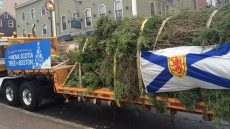OTTAWA — Smart, hardy and friendly — the Royal Canadian Geographic Society says its choice for Canada's national bird epitomizes the best of the country's national traits.
The gray jay, also known as the whiskey jack, was announced Wednesday evening as the winner of the society's laborious two-year search for a fitting avian Canadian representative.
"The gray what?" you may ask.
The gray jay, once known as the Canada jay and the "wisakedjak" of folklore in indigenous cultures, is found in the boreal forests of every Canadian province and territory but nowhere else on the planet.
The robin-sized cousin of the raven and crow has the same brain-to-body ratio as dolphins and chimpanzees, is lauded for its friendliness and intelligence, and spends its entire life in the Canadian woods — observed incubating eggs in temperatures as low as minus 30 C.
"It's a wonderful poster child for the boreal forest, our national and provincial parks, and for climate change," said ornithologist David Bird, part of the expert panel that helped debate the final choice whittled from a list selected by tens of thousands of Canadians.
Well golly, look. They've already started commemorating your momentous decision @CanGeo. #CanadaBird pic.twitter.com/v6dhwviY5d
— DennisVanStaalduinen (@DenVan) November 17, 2016
"So it's a perfect bird for Canada."
The gray jay muscled out higher profile contenders, including the common loon, snowy owl, black-capped chickadee and Canada goose, in a contest that garnered national attention and attracted almost 50,000 online voters.
"That kind of engagement really was certainly not something we expected," Aaron Kylie, the editor of the society's Canadian Geographic magazine, said in an interview.
And it wasn't simply that so many Canadians voted online, or the national media attention.
Grey Jay could our national bird. Over Cardinal or Loon or the CANADIAN Goose! Really Cdn Geographic? #CanadaBird pic.twitter.com/zuDNfsmTNv
— Eye on Stratford (@eyeonstratford) November 17, 2016
"We had thousands of comments, and the comments aren't just a sentence," said Kylie.
"They're paragraphs, they are full pages and they are very impassioned, passionate, personal stories about people's connections to a specific bird they wanted to put forward as the national bird. It almost doesn't matter which bird you'd want to pick in the end."
Wtf is a gray jay?
— Gregorius Maximus (@gdnicholson) November 17, 2016
The federal government has not committed to naming a national bird — let alone the gray jay — but the Canadian Geographic Society argues that Canada's 150th anniversary in the coming year offers a perfect opportunity.
The gray jay actually came third in voting behind the loon and the snowy owl, but was chosen following a public debate and deliberations by a panel. The winner was announced Wednesday evening at the society's annual dinner in Ottawa.

Bird (the ornithologist, not the jay) said the whiskey jack has been shown to be "the smartest bird on the planet."
They're renowned in First Nations lore for warning people of predators in the woods and even leading lost travellers home by calling from tree to tree.
And like the much smaller chickadee, they'll alight on a human hand in the wild to eat proffered seeds without training — even if many urban Canadians have never seen one.
I don't even know what a Gray Jay looks like...what is happening...we have Loons, chickadees, herons sobbing right now... #CanadaBird
— Andrew King (@twitandrewking) November 17, 2016
"Yes, it is a bird that you're really going to have to visit Canada's wild spaces — the boreal forest habitat that it lives in — but if you do, there's a good chance that you will see one," said Kylie.
"Imagine having a bird about the size of a blue jay come and sit on your finger and eat seeds out of your hand. It's unreal."
Jeff Wells, the director of science and policy at the Seattle-based Boreal Songbird Initiative, said Canada's northern forest makes it a unique bird sanctuary.
"Canada's boreal forest plays an extraordinary role in our planet's bird life — its wild, intact landscapes act as a giant bird nursery, producing billions of birds each summer," Wells said in an email.
"It makes sense to nominate a friendly and recognizable bird with such a strong tie to the boreal, and especially one that reflects the hardiness of the Canadian spirit by sticking around and toughing out the cold winters."
Bird noted that among the other five finalists, the loon is already Ontario's provincial bird, the snowy owl is Quebec's bird and the black-capped chickadee is New Brunswick's. Choosing the ubiquitous Canada goose — scourge of urban parks from Georgia to Germany — "would be a terrible mistake, of course," said the ornithologist.
"My feeling is that when we chose the flag of Canada, we did not elevate the provincial flag from Ontario or from Quebec or from New Brunswick," said Bird.
"We chose something fresh and new. And that's what I think we need to do with a national bird."





